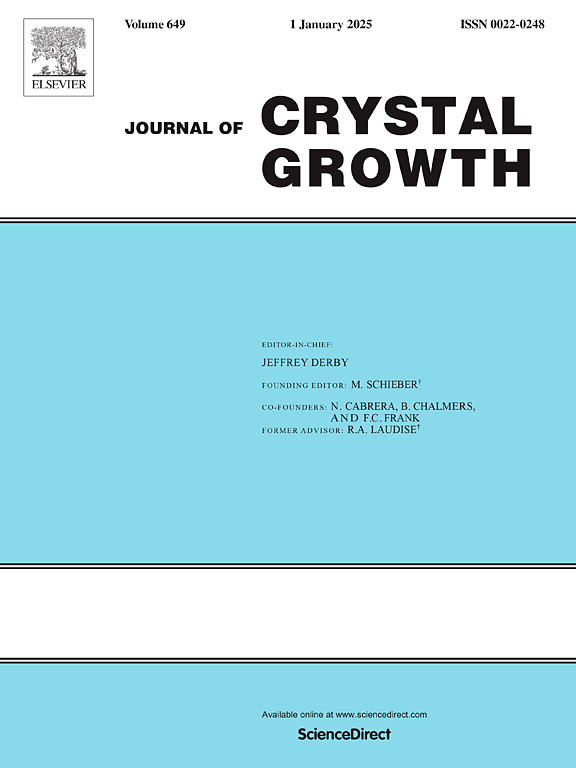A theoretical investigation into the solvent effect on crystal morphology of Nintedanib Esylate by molecular dynamic simulations and experiments
IF 1.7
4区 材料科学
Q3 CRYSTALLOGRAPHY
引用次数: 0
Abstract
Solvent effects play a crucial role in determining the crystal structure of substances obtained from solution. Choosing the appropriate solvent system is vital for the formation of active pharmaceutical ingredients with optimal crystallization characteristics. In this work, the crystal morphology of Nintedanib Esylate under 10 pure solvent conditions was explored using molecular dynamic simulations and experiments. Single crystals of Nintedanib Esylate were prepared by slow evaporation crystallization, and the single crystal structure of Nintedanib Esylate obtained in methanol solvent was determined using single-crystal X-ray diffraction. The results indicated that the crystal form of Nintedanib Esylate was consistent throughout the study. Through structural analysis of the single crystal, it was determined that nintedanib ethosylate is a channel-type hemihydrate with a porosity of 14.8%. The molecular connectivity sites within the crystal were analyzed, and the periodic arrangement trends of the molecules within the nintedanib ethosylate crystal were explored through 2D and 3D structural diagrams. Hirshfeld surface analysis was used to investigate the intermolecular interactions in the crystal structure. The results showed that there are five main types of interactions in the nintedanib ethosylate crystal, namely H···H interactions, O···H/H···O interactions, C···H/H···C interactions, N···H/H···N interactions, and S···H interactions. Among them, H···H interactions accounted for 53.9%, while the S···H interaction was the weakest, contributing only 0.2%. The H···H interactions, representing van der Waals forces, play a dominant role in promoting the formation of the nintedanib ethosylate crystal.Based on the single crystal data of Nintedanib Esylate, the attachment energy model was used to predict the crystal morphology of NE under vacuum conditions. Five major crystal planes were identified, namely {0 0 1}, {0 1 0}, {0 1 1}, {1 0 0}, and {1 1 0}, with the {0 0 1} plane having the largest surface area, accounting for approximately 32.57% of the total crystal surface area.The modified attachment energy model was used to predict the crystal morphology of Nintedanib Esylate in different solvents. The results showed that the modified attachment energy model predictions were consistent with the crystal habits obtained by evaporative crystallization, and it was predicted that the aspect ratio of the simulated crystal habit was smallest in methanol, isopropanol, and n-propanol, and largest in n-butanol and ethanol, which can be used for further optimization of crystallization processes and solvent selection for production.The diffusion ability of solvent molecules on the crystal surface is the key factor to determine the crystal growth rate. The dominant crystal surface {0 1 0} in ethanol, isopropanol, acetone, DCM and DMF solvent systems and the dominant crystal surface {1 1 0} in n-propanol solvent system have the largest diffusion coefficients and the smallest relative growth rates.This work provides valuable insights for selecting solvents in the crystallization process of Nintedanib Esylate, with methanol, isopropanol, DCM, n-propanol, acetonitrile, and DMAC recommended based on the production conditions.
求助全文
约1分钟内获得全文
求助全文
来源期刊

Journal of Crystal Growth
化学-晶体学
CiteScore
3.60
自引率
11.10%
发文量
373
审稿时长
65 days
期刊介绍:
The journal offers a common reference and publication source for workers engaged in research on the experimental and theoretical aspects of crystal growth and its applications, e.g. in devices. Experimental and theoretical contributions are published in the following fields: theory of nucleation and growth, molecular kinetics and transport phenomena, crystallization in viscous media such as polymers and glasses; crystal growth of metals, minerals, semiconductors, superconductors, magnetics, inorganic, organic and biological substances in bulk or as thin films; molecular beam epitaxy, chemical vapor deposition, growth of III-V and II-VI and other semiconductors; characterization of single crystals by physical and chemical methods; apparatus, instrumentation and techniques for crystal growth, and purification methods; multilayer heterostructures and their characterisation with an emphasis on crystal growth and epitaxial aspects of electronic materials. A special feature of the journal is the periodic inclusion of proceedings of symposia and conferences on relevant aspects of crystal growth.
 求助内容:
求助内容: 应助结果提醒方式:
应助结果提醒方式:


